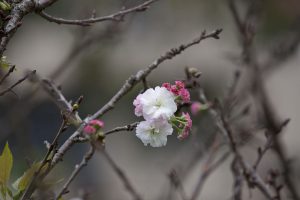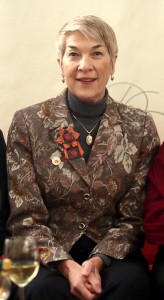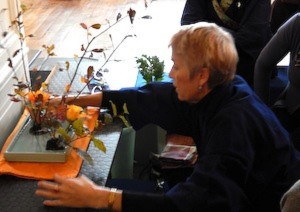Thursday
Arts and PoetryNatural Flowers
Part one of a three-part series exploring the broader meanings of ikebana
by Marcia Shibata, with guest editor Crystal Gandrud
 Sometimes I’m asked why Shambhala Centers have Asian style flower arrangements. After all, we are in the west, right? We could make western arrangements much faster. We could copy arrangements by famous lifestyle gurus, and then perhaps become a flower guru artist of Shambhala. Or we could order arrangements online and have them delivered so we would not have to clean up our own mess.
Sometimes I’m asked why Shambhala Centers have Asian style flower arrangements. After all, we are in the west, right? We could make western arrangements much faster. We could copy arrangements by famous lifestyle gurus, and then perhaps become a flower guru artist of Shambhala. Or we could order arrangements online and have them delivered so we would not have to clean up our own mess.
But there are very good reasons why we do not do any of this. Like so much of what one experiences in Shambhala Centers around the world, it began with Chögyam Trungpa Rinpoche. While studying at Oxford University, Rinpoche met a British ikebana teacher named Stella Coe. Coe’s husband was a diplomat stationed in Japan after the Second World War, assisting in the reconstruction efforts. She accompanied him and discovered ikebana. We have Mrs. Coe to thank for teaching Rinpoche this sacred art form.
China is the origin of contemplative flower practice, where it was known as “kado” (huadao in Pinyin) or “Way of flowers,” an analogy for the Way of all life not only plant material.
“Ka” means flower; “do” comes from “Tao” or The Way. The practice began about 2300 AD but perished in China due to war and political upheaval around 1000 years ago. Fortunately Japan had imported kado as it was absorbing and cultivating Buddhism about 1500 years before. Kado was renamed “ikebana” in the Japanese language, meaning “to give life to flowers.”
 This new name of “Ikebana” points to the fact that plants in their natural setting are perfect expressions of “pure” life spirit and all this involves. But by gathering materials through cutting things from their mother root before or in their prime, the flowers and branches are hastened on the way to death. Much more so than if they were left to have their natural existence in a garden or in the wild. With this awareness, respect, and much care a flower practitioner can possibly extend the life of gathered materials for perhaps a little longer.
This new name of “Ikebana” points to the fact that plants in their natural setting are perfect expressions of “pure” life spirit and all this involves. But by gathering materials through cutting things from their mother root before or in their prime, the flowers and branches are hastened on the way to death. Much more so than if they were left to have their natural existence in a garden or in the wild. With this awareness, respect, and much care a flower practitioner can possibly extend the life of gathered materials for perhaps a little longer.
Pure life spirit gives rise to natural and simple expression. Modest yet rich and clear, individual but interdependent with all that shares life; it is in the now. Simultaneously plant material gives and receives according to what is needed; supportive for all, it is completely in harmony and relaxed with life and death, its own death and the death of all that shares existence.
Kado or ikebana practice can assist us in understanding, expressing, and living by the three Taoist pillars of life in a natural authentic way. All “do” practices are founded on these principles; by truly understanding them, they can return us to and hold us within inherent wisdom. This inherent wisdom in nature and in humans is the same because we are an expression of nature, a part of nature; we are not separate.
The three Taoist principles of Heaven, Earth, and Man are not a democratic idea of equal relationship with one another. Rather they are a natural hierarchy in which there is guidance and the following of guidance, a surrendering to this guidance. “Natural” is important to understand because nature is not contrived, arranged, controlled, or a fixed idea. Things are given space to flow and change within the hierarchical structure. “Guidance” is a polite translation for the Heaven principle. In China, Heaven principle is mandate, law. All life forms—rocks, water, worms, cells, cabbages, foxes, trees, humans—are subject to the law/s of the universe. If natural law is not recognized and followed, there is continuous struggle, suffering, clouded views of reality, and confusion can easily take over leadership. All of life’s expressions are interdependent, beyond one, beyond separation; they continue to flow and change within the hierarchal structure. There is no bargaining or questioning when it comes to the mandate of Heaven.
 Marcia Wang Shibata serves as Artist to the Kalapa Court, and as Master Instructor of Shambhala Kado Rigden School of Ikebana.
Marcia Wang Shibata serves as Artist to the Kalapa Court, and as Master Instructor of Shambhala Kado Rigden School of Ikebana.






Mar 2, 2018
Reply
Hi Sylvie,
Looks like that should have been BC rather than AD. Thanks for your correction!
Mar 2, 2018
Reply
Reading the date given above (2300AD) for a start date of Kado, I am left in a bit of a quandry. Something seems off there – in fact I read that as a date in the future, no? Could you kindly clarify?
Mar 1, 2018
Reply
Thank you Marcia and Crystal! The wisdom teachings are much appreciated!